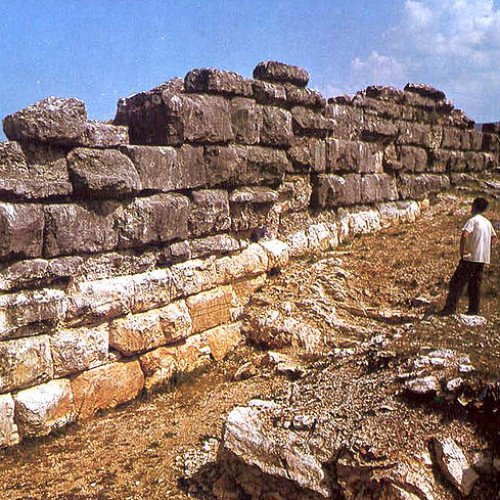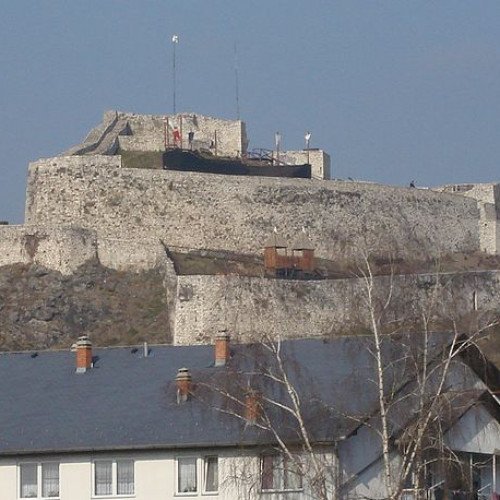Castles of "Bosnia and Herzegovina" DAORSON vs DOBOJ FORTRESS

DAORSON
Daorson (Ancient Greek: Δαορσών) was the capital of the Illyrian tribe of the Daorsi (Ancient Greek Δαόριζοι, Δαούρσιοι; Latin Daorsei). The Daorsi lived in the valley of the Neretva River between 300 BC and 50 BC. They came very early into contact with Greek traders acquiring many facies of Greek civilization, and the town acquired a certain degree of Hellenization. The ruins of Daorson can be found at Ošanići, near Stolac, Bosnia and Herzegovina. Daorson was built around a central fort or acropolis, surrounded by cyclopean walls made of huge stone blocks (similar to those in Mycenae, in Greece). The acropolis would have housed all of the important administrative, public and religious buildings. The defensive wall extending from southwest to northeast was 65 metres long, 4.2 metres wide, and from 4.5 to 7.5 metres high with doors and towers on both sides. The Daorsi used the Greek language and alphabet and kept trading relations with the Greeks. The remnants of numerous wine amphorae have been found, including some ceramic fragments. The most valuable of the finds is a bronze helmet decorated with a series of Greek mythological figures, including Aphrodite, Nika, Heli, Dionysius, Muse, Pegasus. The inscription on it is similar to the inscription on a helmet found in North Macedonia. The remnants of a granite sculpture of Cadmus and Harmonia have also been found. This piece includes an Illyrian relief with thirteen snakes and five pairs of eagle's wings. A small building housed a mint facility. Thirty-nine different coins were discovered in this building, the majority (29) depicted King Ballaios, who ruled after 168 BC. Nine of the recovered coins had a Greek inscription with an image of a boat. Money was of immense importance to the Daorsi, allowing the tribe to remain independent while securing their business, cultural and trade links with other groups.
Statistics for this Xoptio

DOBOJ FORTRESS
Doboj Fortress (Bosnian, Croatian and Serbian: Dobojska tvrđava / Добојска тврђава) or Gradina (Градина) is located in the city of Doboj, Bosnia and Herzegovina. Throughout its turbulent history, this magnificent object has been burned and ransacked at least 18 times as per official records. Of note is that Doboj fortress was considered to be a royal Kotromanić property, unlike Great Bosnian Duke Hrvoje's Zvecaj fortress or Sandalj Hranić's Blagaj fortress, which were centers of their respective dukedoms. One of the most important defenses in the medieval banate/duchy of Usora, this large stone structure was built in the early 13th century on the site of an earlier, clay and wood-based structure from the 10th or 11th century. In the first period of its existence, from early 13th to about early 15th century (1415), the fortress was built in the Romanesque architecture style. The watchtower and lower fort Doboj fortress underwent a major reconstruction in the spring of 1415. While still retaining some of its original Romanesque elements, the fortress now displayed Gothic structure and had its large keep reinforced with thick walls - up to 3 feet or about 1 meter thick at the Eastern wall. Northern tower received an addition of a bastion/plateau with six cannon. The captain's tower was turned into even more dominating feature, a 5-stories tall donjon. Its perfectly square base and considerable height were not typical for Usora castles of the time. Moreover, additional outer walls were built around the original triangular core and three big towers (Northern, Eastern, and Southern Gate) have been strengthened as well. These towers strategically protected flanks of the fortress, hence rendering any idea of an attack a suicidal attempt. The Southern tower's walls, in particular, were changed into round shape in order to deflect cannonballs (circa 1370-1380s) and local captains at the time used Dubrovnik-made cannons, bombards, and balistas as the fortress' main defense weaponry. Since early 14th century, there was a small contingent permanently stationed at the fortress and it was armed with swords, lances, halberds, bows, crossbows, and later on, handguns. Much of the weaponry was locally made but finer equipment was imported from Germany, Venice, and Dubrovnik. The latter was known as Republic of Ragusa at the time and its merchants travelled and traded regularly throughout medieval Usora and Bosnia. Ragusan engineers also built the water cistern in the upper fort of Doboj.